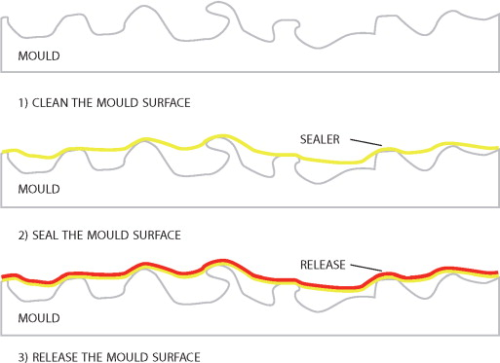
The performance of a mould release coating very much depends on how well the mould surface has been conditioned or sealed. A good mould conditioner, often called sealer, will provide an even surface that can offer multiple release performance with a variety of tool materials and release agents. Unfortunately, on many occasions the importance of mould conditioning is often overlooked.
Surface conditioning
Microscopically speaking any type of material exhibits some degree of porosity. Surface micro-porosity cannot be seen with the naked eye nor can it be easily quantified. However, the effects of surface micro-porosity on release performance are clearly noticeable. The application of a good mould conditioner may provide a tool surface free of porosity, which in turn will significantly improve part release.
Micro-porosity is often associated with materials rather than surfaces. For instance, it is very common to hear it said that “glass has got no porosity” or “aluminium is less porous than composite”. While in many cases this is true, it is also true that some cast aluminium tools may exhibit more porosity than some composite tools. As stated before, micro-porosity cannot be seen or quantified easily. Thus, we should never take for granted that a certain type of material needs, or does not need, to be sealed.
Instead, the most prudent option is to apply a sealer coating regardless of the tool material surface in order to homogenise the inherent micro-porosity that every surface has. By doing so, we will create an even platform that will accommodate the release coating as well as reduce the quantity to be applied. Sealing a tool surface with an excess of release agent is costly and inefficient.
Zyvax recommends applying a high performance mould sealer and afterwards small quantities of release agent in order to enhance slip. It is important to bear in mind that a high performance mould sealer will not provide high slip to the tool but will prevent any resin stick-up. A good mould sealer is the best insurance against damage caused by resin chemical bonding.
Mould sealer: working principle
A mould sealer must be applied on a very clean tool surface. The surface should be free of any contaminants so that it exhibits water break-free features.
The sealing coating must bond well to the tool surface in order to withstand many release cycles. If the tool is not clean, then the sealer may be removed after some pulls due to poor adhesion to the tool surface.
Sealing will be more efficient by application of several thin coatings rather than a single thick one. In some cases, baking of the sealing coating may be required to improve overall performance.
Types of mould sealers
A universal mould sealer is the ideal product for mould conditioning. However, this ‘universal’ product may not be effective in many cases. There are so many types of tool surfaces, resins, gel-coats and diverse moulding variables that it is almost impossible to find an ideal universal sealing coating.
Zyvax recommends Sealer GP as a universal mould conditioner. This product will effectively seal most surfaces, creating a durable and resilient polymeric coating. The product cures at room temperature and is very effective with tools made of aluminium, steel, iron, invar, composite, glass, rubber, and wood.
Some type of abrasive moulding techniques may require a harder coating that will withstand aggressive environments. Zyvax recommends the application of SealProof, a solvent-free sealer with inorganic fillers in the formula. This product is a true polymer that offers a matt surface with a superior abrasion resistance. This product may convert a glossy tool into a matt one without compromising its sealing performance. A mild baking may be required in order to achieve a high degree of polymer cross-linking.
Long life, improved release
The use of a good mould conditioner will provide a long lasting working life for the tool as well as improving release performance. It ensures multiple releases and minimises the use of release agent. Moreover, the sealing coating can actually change the gloss level of the surface without altering the tool dimensions.
Application of a high performance mould conditioner is essential in moulds that need to withstand high production cycles with little release agent touch up in between.






